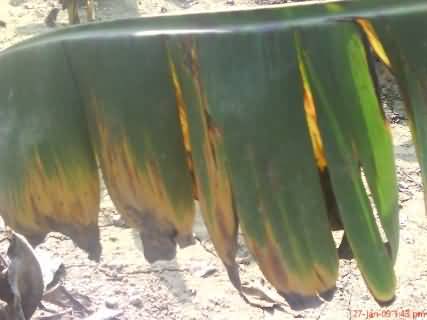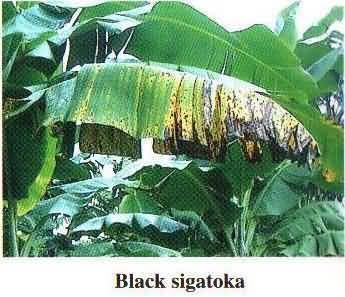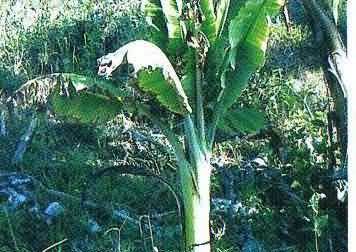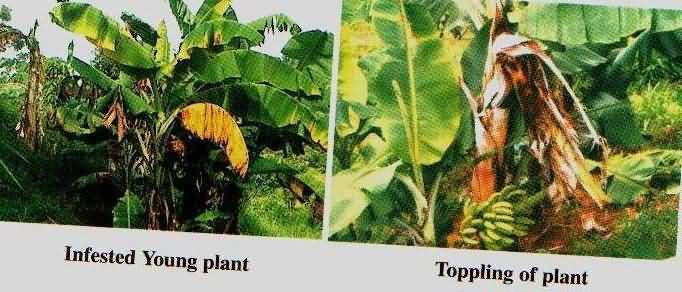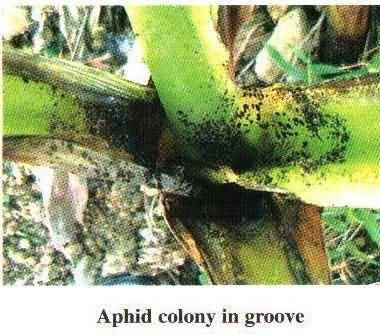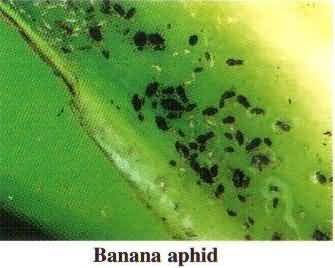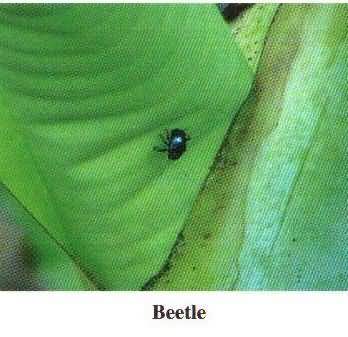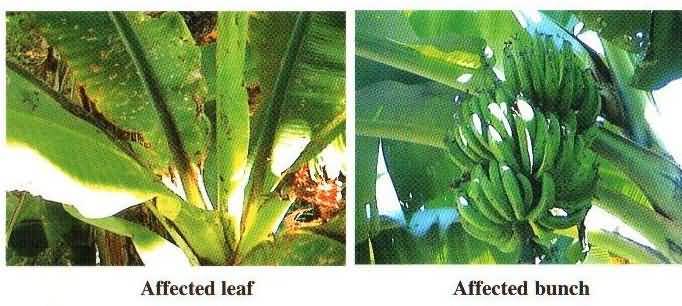केले केे महत्वपूर्ण रोग, कीट व पतंग तथ्ाा उनका प्रबंधन
Timely identification of pests and diseases in agriculture helps farmer to properly control and manage them. Major pests and diseases that affect the banana crop and their management are discussed below.
Diseases of Banana Crop
(Fusarium oxysporum f. sp. cubense):
This is a soil-borne fungal disease and gets entry in the plant body through roots. It is most serious in poorly drained soil. Initial symptoms are yellowing of lower leaves, including leaf blades and petioles.
The leaves hang around the pseudostem and wither. In the pseudostem of the diseased plant, yellowish to reddish streaks are noted with intensification of colour towards the rhizome.
Wilt is severe in poor soil with continuous cropping of banana. Warm soil temperature, poor drainage, light soils and high soil moisture are congenial for the spread of the disease.
Control:
Severely affected plants should be uprooted and burnt. Highly infected soil should not be replanted with banana at least for 3-4 years. Use of disease-free planting material and resistant cultivar are recommended.
Growing of paddy followed by banana for 3-5 years once or twice, use of quick lime near the base of the plant and soaking with water and avoiding sunflower or sugarcane in crop rotation helps to reduce the disease incidence.
Dipping of suckers in Carbendazim (10g/10 litres of water) followed by bimonthly drenching starting from 6 months after planting is also recommended. Application of bioagents, such as, Trichoderma viride or Pseudomonas fluorescence in the soil is effective.
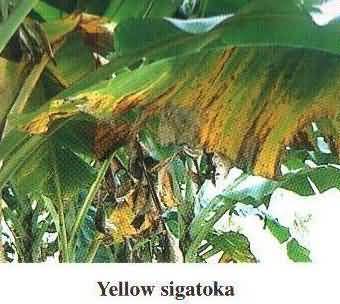 2. Leaf Spot, Leaf Streak or Sigatoka Disease
2. Leaf Spot, Leaf Streak or Sigatoka Disease
(Mycosphaerella musicola):
Yellow sigatoka is one of the serious diseases affecting the banana crop. Initial symptoms appear in the form of light yellowish spots on the leaves.
A small number of these enlarge, become oval; the colour also changes to dark brown. Still later, the centre of the spot dies, turning light grey surrounded by a brown ring.
In severe cases, numerous spots coalesce, killing large parts of the leaf. Rainfall, dew and temperature determine the spread of the disease.
Conditions favouring mass infection are most common during the rainy season with temperature above 21øC.
Cultural practices such as improved drainage, control of weeds, removal of diseases suckers and adopting correct spacing is recommended.
Dithane M-45 WP (in oil-water emulsion) and Dithane M-45 (in water only) controlled Mycosphaerella fjijiensis var.
difformis in banana. Foliar spray of Copper Oxychloride (3 g/litre of water) or Thiophanate Methyl 1 g/ litres of water) control the disease effectively.
3. Anthracnose
(Gloeosporium musae):
The disease attacks banana plants at all stages of growth. Disease attacks the flowers, skin and distal ends of banana heads. The symptoms appear as large brown patches covered with a crimson growth of the fungus. The disease fruit turns black and the fruit is shrivelled.
Control:
Spraying of Chlorothanlonil (0.2%) and Bavistin (1 %) four times at 15 days interval is recommended. Minimising bruising; proper sanitation of handling and prompt cooling to 14øC are essential in minimising the disease in cold storage.
4. Cigar End Tip Rot
(Verticillium theobromae, Trachsphaera fructigena and Gloeosporium musarum):
A black necrosis spread from the perianth into the tip of immature fingers. The rotted portion of the banana finger is dry and tends to adhere to fruits (appears similar to the ash of a cigar).
Control:
Removal of pistil and perianth by hand 8-10 days after bunch formation and spraying the bunch with Dithane M -45 (0.1%) or Topsin M (0.1%) controls the disease effectively. Minimising bruising; prompt cooling to 14øC; proper sanitation of handling facilities reduce the incidence in the cold storage.
5. Crown Rot
(Colletotrichum musae, Fusarium sp., Verticillium theobromae, Botryodiploidia theobromae and Nigrospora sphaericu) :
The characteristic symptoms are blackening of the crown tissues, which spreads to the pulp through the pedicel resulting rotting of the infected portion and separation of fingers from the hand.
Control : Dipping the bunches or hands in Thiobendazole or Benomyl and/or using fungicide impregnated cellulose pad for packing is recommended.
6. Stem-end Rot
(Thielaviopsis paradoxa):
The fungus enters through the cut stem or hand. The invaded flesh becomes soft and water-soaked.
Control :
Minimising bruising; prompt cooling to 14øC; proper sanitation of handling facilities and hot water treatment of hands (such as 5 minutes in 50øC water) helps in controlling the disease in cold storage.
7. Pseudostem Heart Rot
(Botrydiplodia sp.,Gloeosporium sp. and Fusarium sp.) :
The first indication of heart rot is the presence of heart leaves with part of the lamina missing or decayed. In severe cases, the inner leaves of the crown first turn yellow, then brown and finally die. In more severe cases all the leaves and the plant die.
Control :
Adopting field sanitation, good drainage and proper spacing reduce the incidence of the disease. To prevent spread of the disease, spraying of Captan or Dithane M-45 or Dithane Z- 78 is effective.
8. Head Rot
(Erwinia carotovora):
Newly planted suckers get affected, leading to rotting and emitting of foul odour. In older plants rotting at the collar region and leaf bases are seen. In advanced cases, trunk base becomes swollen and split.
Control :
Good drainage and soil conditioning can control the disease to some extent. Use of rhizomes with dead central buds and active lateral buds prevents the appearance of the disease.
9. Bacterial Wilt or Moko Disease
(Pseudomonas solanacearum):
The young plants are affected severely. In the initial stages the bacterial wilt is characterised by the yellowish discolouration of the inner leaf lamina close to the petiole. The leaf collapses near the junction of the lamina with the petiole.
Within a week most of the leaves exhibit wilting symptoms. The presence of yellow fingers in an otherwise green stem often indicates the presence of moko disease. The most characteristic symptoms appear on the young suckers that have been cut once and begin regrowth.
These are blackened and stunted. The tender leaves from the suckers turn yellow and necrotic.
Control :
Early detection and destruction of the suspected plants may help in preventing the spread of the disease. All the tools used for pruning and cutting should be disinfected with formaldehyde.
As the insects can carry the disease causing bacterium on the male flowers, removal of the male flowers as soon as the last female hand emerge help in minimising the spread of the disease.
(BBTV):
The disease is transmitted to the plant by the aphid vector Pentalonia nigronervosa and dwarf bananas are very susceptible to this disease. Primary symptoms of the disease are seen when infected suckers are planted.
Such infected suckers putforth narrow leaves, which are chlorotic and exhibit mosaic symptoms. The affected leaves are britttle with their margins rolled upwards.
Characteristic symptom of bunchy top virus is the presence of interrupted dark green streaks along the secondary veins of the lamina or the midrib of the petiole. The diseased plants remain stunted and do not produce bunch of any commercial value.
Control :
Systematic eradication of the diseased plants, suckers and the clumps is very essential. Planting materials should not be collected from places affected by this disease.
The aphid should be controlled to check spread of the disease by spraying with Metasystox (0.1-0.5%). Plants adjacent to the healthy plants should also be sprayed.
The affected plant should be killed with kerosene or herbicides such as 2, 4-D or 2, 4, 5-T. The rhizome should be dug out, cut into small sections and sprayed again so that no suckers can be produced which may harbour the virus.
11. Banana Streak Virus
(BSV) :
A prominent symptom exhibited by BSV is yellow streaking of the leaves, which becomes progressively necrotic producing a black streaked appearance in older leaves.
The virus is transmitted mostly through infected planting materials, though mealy bugs (Planococcus citri) and more probably Saccharicoccus sacchari are also believed to transmit it. Shoot tip culture does not eliminate it from vegetatively propagated materials.
Control:
Control strategies include use of clean planting material and quarantine. Eradication of infected plants and control of vectors are effective in controlling the severity of the disease.
12. Mosaic Virus:
The disease is characterised by typical mosaic symptoms on the leaves. Mosaic plants are easily recognised by their dwarf growth and mottled, distorted leaves. The earliest symptoms appear on young leaves ass light green or yellowish streaks and bands giving a mottled appearance. The aphid vector Aphis gossypii transmits the disease.
Control:
The plantation should be kept free from weeds. Suckers from infected clumps should not be used for planting. Weeds in the nearby area should be removed as the virus survives in them during offseason. Use of suitable insecticide to reduce spread of the disease is also suggested.
13. Banana Bract Mosaic Virus
(BBMV):
The symptoms appear as yellow green bands or mottling over an entire area of young leaves. The affected leaves show abnormal thickening of veins. Bunch development is affected.
Control:
Removal and destruction of affected plants along with rhizome. Growing cucurbits in and around banana field should be avoided.
Insects and Pests of Banana
1. Pseudostem Borer
(Odoiporus longicollis) :
Adults are either reddish brown or black. The pest is active during summer and monsoon months. The grubs bore into the stem and feed within the stem. An initial symptom is in the form of exudation of plant sap and blackened mass that comes out from the hole bore by the grub. Finally the whole plant dies.
Control:
In case of severe infection the affected plants should be uprooted and burnt. Celphos (3 tablets/plant) is recommended for control of egg, larva, pupa and adult population of the insect, application of. After placing the tablet inside the pseudostem, the slit should be plastered with mud.
Clean cultivation is an important measure for its control. Application of Carbofuran (3 g of granules/stool) is very effective to control the pest. Alternately, application of Endosulphan (0.04%) or Carbaryl WP (0.1%) also controls the pest population.
2. Rhizome Weevil
(Cosmopolites sordidus) :
The larvae or grub of the weevil borer feeds by tunnelling in the banana plant. In severe cases, the tunnels extend several feet up the stem. The corm decays and becomes a mass of rotten tissue.
Injury to corm prevents nourishment going to the plant. Leaves turn yellow, wither and die maturely. In heavily infected plantations, production is low. Adults feed on dead or dying banana plants and live under newly cut or rotting pseudostems.
The female weevil either lays its eggs in the rotting pseudostem or moves to a living plant where eggs are inserted singly into a hole. The borers spread from plantation to plantation through planting material.
Control :
Plantations should be clear of debris in which borers can survive. It is most important to use clean planting material from fields, known to be free of weevils. Pieces of old rhizomes or pseudostems 1-2 feet long are cut down split and placed on the plantation floor between plants.
Adult beetles migrate into these stems and can be collected by hand and poisoned. Before planting dipping of suckers in Monocrotophos (0.5%) for 30 minutes to protect rhizome from weevil attack.
3. Banana Aphid
(Pentalonia nigronervosa):
The insect, is the vector of the virus causing bunchy top disease. Yellowish green nymphs and adults suck cell sap and devitalise plants. Affected parts become discoloured and malformed. High humidity favours rapid multiplication of this pest. The aphids are mostly observed on the lower surface of the leaves.
Control:
Spraying of Monocrotophos (0.05%) or Malathion (0.1%) at 10-15 days interval contains aphid population effectively. To prevent recurrence of the pest granular insecticides like Phorate @ 1.0 kg a.i./ha should be applied to soil.
4. Fruit and Leaf Scarring Beetle
(Colaspis hypochlora) :
Occurrence of this pest is usually high during the rainy season. The adult beetle feeds on young leaves and skin of young fruits. Infested fruits get spotted and severe scarring of fruit skin leads to underdeveloped fruit of less commercial value.
Control:
Removal of grass weeds from plantations where the population of this pest is high can often reduce the population levels enough to avoid the use of insecticides. Unless the beetles are causing serious economic losses the use of insecticides should be avoided.
In case of severe infestation spraying with Endosulphan (0.04%) or Carbaryl WP (0.1 %) controls the pest population.
5. Burrowing Nematode
(Radopholus similis):
The first symptom of the disease is a small dark spot on the root. The nematode deposit eggs in the root tissue. Larvae after hatching form the eggs feed on the root tissue. Fungi rapidly invade such damaged root tissue.
The number of fruits in the bunch is reduced and individual fruits are small. Affected plants do not respond to fertilizers, irrigation or cultural practices. Nematode population is built up rapidly in ratoon crops.
Control :
Application of Carbofuran 3G or Phorate 10G @10 g/pit at the time of planting or application of neem cake (250-400 g/pit) at the time of planting reduces the pest population. Control measures such as application of nematicides to the growing infected plants and planting of nematode-free corms in fallow soil are recommended.
Recently granular nematicides are becoming popular. They are easy to apply by hand to the soil around the mat at times combined with fertilizers. Some have systemic action. They are carried down into the soil by rain or irrigation water. Three applications of Nemacur (Phenamiphos) are effective in controlling the nematodes.
Disorders in Banana
1. Chilling Injury:
Symptoms include surface discoloration, sub-epidermal tissues reveal dark-brown streaks, failure to ripen, and, in severe cases, flesh browning. Chilling injury results from exposing bananas to temperatures below 13øC for a few hours to a few days, depending on cultivar, maturity, and temperature.
2. Skin Abrasions:
Abrasions result from skin scuffing against other fruits or surfaces of handling equipment or shipping boxes. When exposed to low (<90%) relative humidity conditions, water loss from scuffed areas is accelerated and their colour turns brown to black.
3. Impact Bruising:
Dropping of bananas may induce browning of the flesh without damage to the skin.Bananas are harvested raw and ripened artificially. The dwarf bananas are ready for harvest within 1114 months after planting, while tall cultivars take about 14-16 months to harvest.
A bunch usually takes 90-120 days to mature after shooting, depending on climate and cultural practices. The maturity of banana is indicated by drying of top leaves, change in colour of fruits from dark green to light green and tendency of the floral end of the fruit to fall by slightest touch by hand.
The mature fruit becomes plumpy and all the angles are filled in completely. When tapped the fruit gives metallic sound. The method of harvesting depends on the height of the plant. Low growing varieties are harvested by cutting through the bunch stalk about 30-35 cm above the top hand.
With taller varieties, the stem of the plant will be partly cut through to bring the bunch down within the harvester's reach.
Authors:
Gaurav Kumar Singh
Research coordinator,
Centre for Agri Solutions and Technology (CAT)
Tata Chemicals Ltd., Aligarh.
E-mail:

